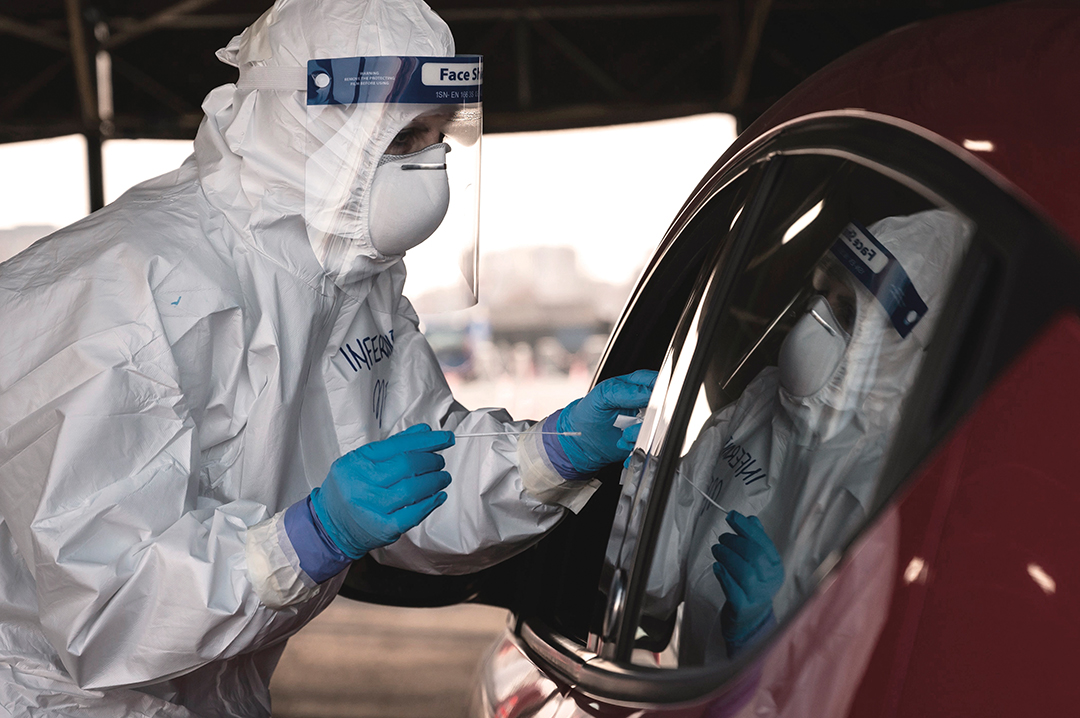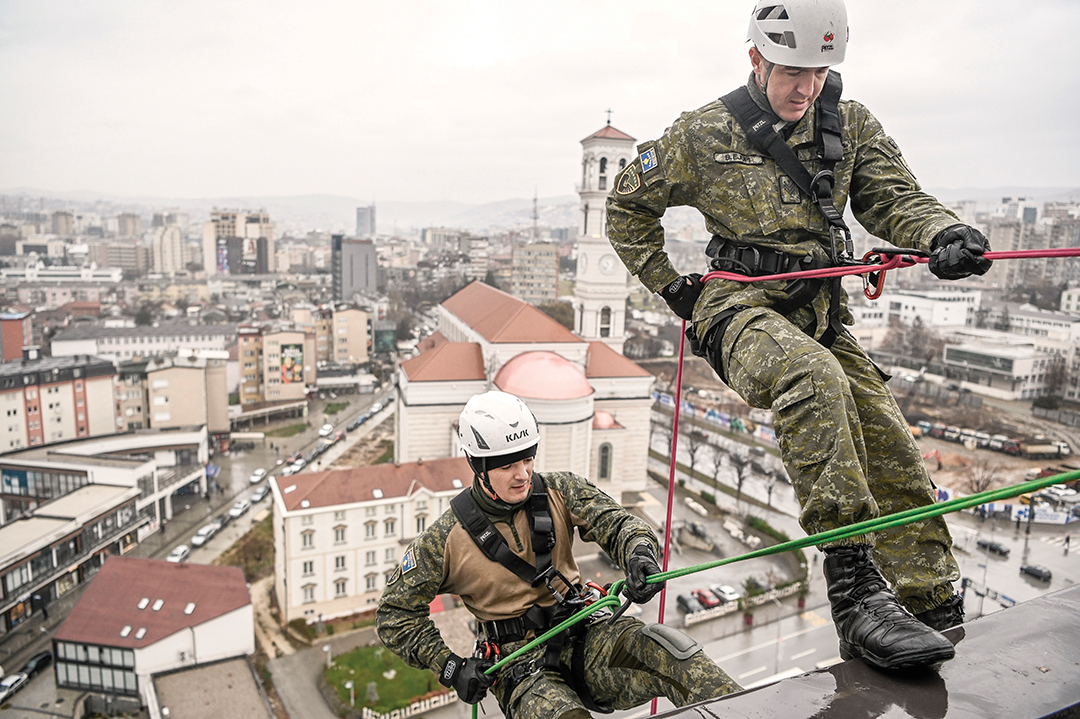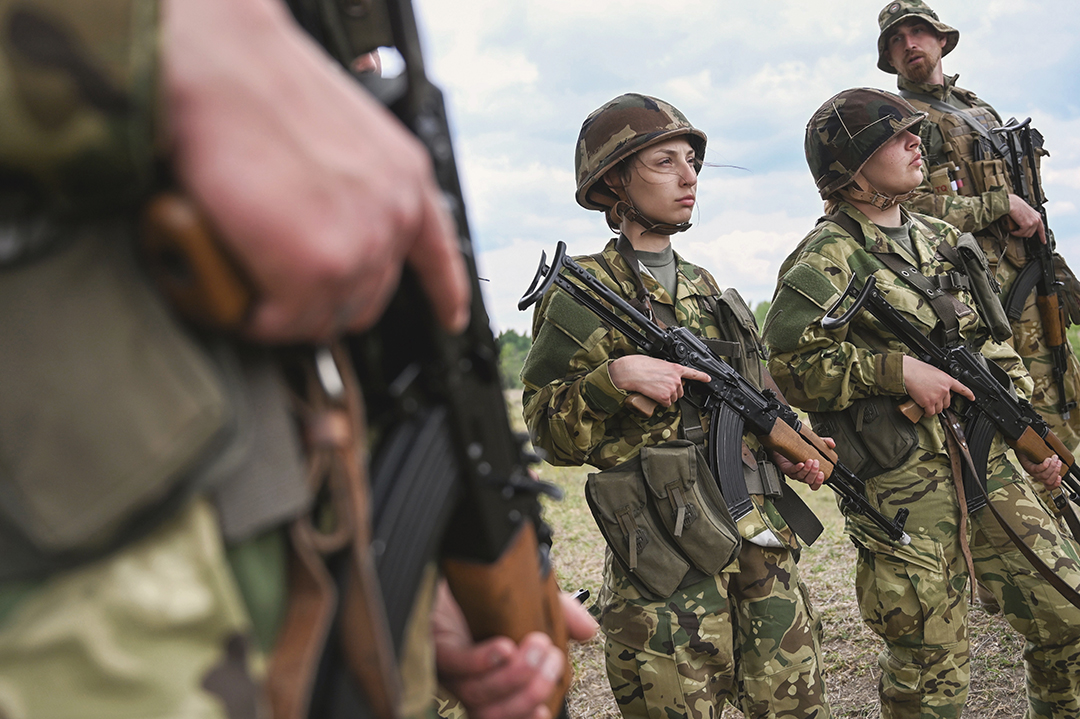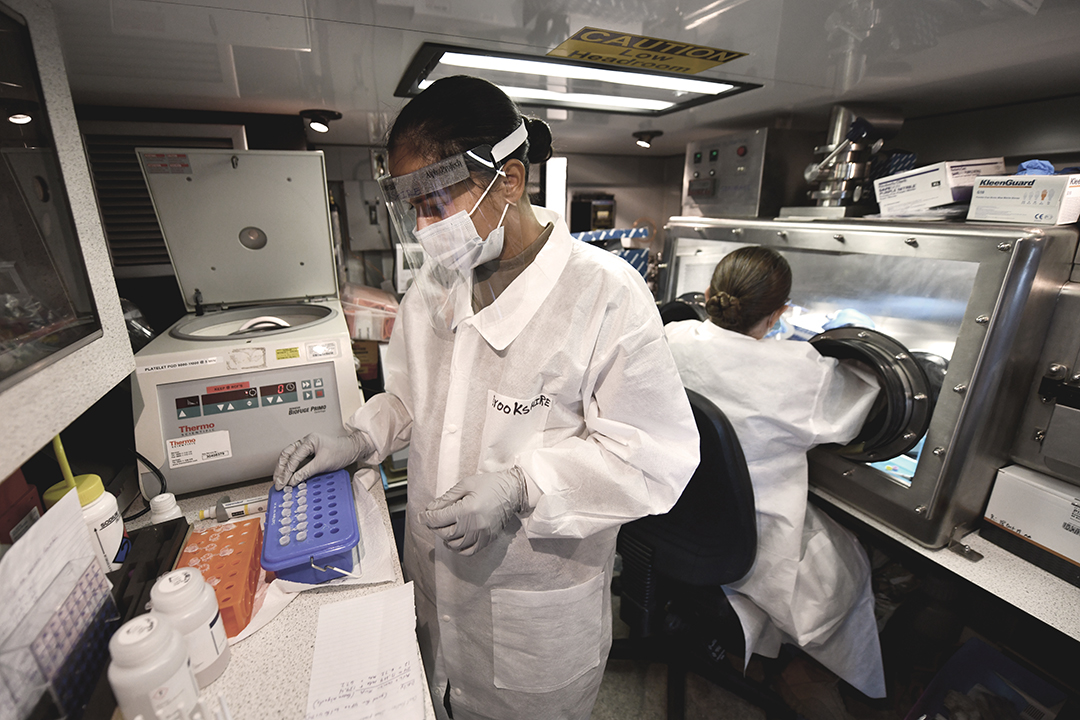What Armed Forces Can Do
By Dr. John L. Clarke, Marshall Center professor
The pandemic has caused leaders across the globe to turn to their armed forces for support in an ever-expanding range of roles. As the COVID-19 crisis progressed and the tragedy intensified, armed forces assumed roles never before anticipated as countries reached the limits of what their civilian health organizations could provide. These demands are expected to mount even as the crisis abates. The range of roles, missions, tasks and functions of armed forces during this crisis can be placed within six mission sets under the Defense Support to Civil Authority (DSCA) rubric. Decision-makers must contemplate important considerations before asking the armed forces to undertake these roles.
Many of the tasks inherent in the DSCA have been prominent in the demands from political leaders for armed forces support during the pandemic, such as providing essential services (often logistical and medical) as well as search capabilities, decontamination operations and engineering support. For example, armed forces in Italy, Spain, France and the United States, just to name a few, have built and staffed medical facilities, transported virus patients, delivered food supplies, searched buildings for victims, and decontaminated residences and public facilities, such as train stations and airports.
In addition, armed forces have provided mortuary services, including the transportation and cremation of virus victims’ remains.
Photos show convoys of Italian Army trucks loaded with coffins. Soldiers have provided medical support to overwhelmed facilities. Photos also show soldiers administering tests for the virus, moving patients within hospitals and providing basic services, such as changing bed pans and providing meals, all in a contaminated environment. French military aircraft, equipped for medical evacuation, have transported virus patients to less-stressed medical facilities in France. As societies come under increasing — and unrelenting — pressure due to the pandemic, political leaders are increasingly turning to the armed forces to provide support for their police and security forces as well as for stressed medical and public health organizations. The range of roles and tasks that armed forces personnel are being called upon to support is expanding rapidly and will have significant impacts on the ability of those military organizations to perform their principal missions as the COVID-19 crisis continues.

In Western countries, the armed forces have a long and honorable history of supporting civil authorities in coping with domestic contingencies. For many countries, particularly in Europe, supporting the civil authority is a principal military mission, equal to defending national security. In others, particularly in Africa and Asia, domestic issues are the principal focus of the national armed forces. Thus, the tradition of armed forces support for the civil authority — and in some cases even supplanting it — is well established.
The COVID-19 crisis of 2020-2021 has added another extreme dimension to this tradition; for the first time in many years, there has been talk of martial law in some countries should the political situation erode to the point where police and other law enforcement are unable to manage public security effectively. While still very much a nightmare scenario, if the crisis deepens, food may become scarce and the health threats so terrifying that law, order and stability begin to break down.
Short of that, national authorities are increasingly relying on military forces to take on a novel range of public tasks in response to the crisis. Given the trends in contemporary societies, it is worth exploring what political leaders are asking soldiers to do and where it may lead, for the demands on those forces are likely to grow.
Missions at home
In the domestic context, there are essentially two mission sets: homeland defense and civil support. Homeland defense is the traditional task of defending the population, infrastructure and sovereignty of a nation against outside threats. This may involve such tasks as border defense (as differentiated from border security), air defense and defense of maritime approaches.
Of course, most military forces in NATO countries were designed for the Cold War mission of defending against the possibility of a Warsaw Pact attack; their legacy organization and equipment bear witness to this. However, while many European countries still retain relatively large numbers of soldiers on the books, they are not necessarily organized, configured, trained and equipped for modern, conventional, high-intensity operations.
In addition to homeland defense, NATO military forces have always been heavily involved in the second homeland mission, that of civil support, or DSCA. It supports civil authority, with responsibility and overall command remaining with that civil authority. These tasks include assistance to local authorities during disasters as well as support to law enforcement authorities for select tasks. They may also include actions taken by the military to restore law, order and stability in the aftermath of a major catastrophe or an insurrection. Such operations may involve active and reserve forces as well as some specialized capabilities, such as airborne radar for border surveillance. In every event, the key is that civilians remain in control.
Some observers refer to this differentiation of roles in a domestic context as the tension between traditional and nontraditional roles. Inherent is the concept that homeland defense is the traditional role of armed forces, and all other undertakings are nontraditional in nature. However, this bifurcation fails to recognize that armed forces have been employed in many domestic roles, particularly domestic security roles, for centuries. The rise of professionalized, if not fully professional, armed forces is a fairly recent phenomenon, which drew upon the domestic security activities that European armed forces have long played. For example, many of today’s militarized police forces, such as the French Gendarmerie, originated within and spent decades as part of their nation’s armed forces, only having returned to their law enforcement roles in the post-World War II era.

Indeed, the range of tasks for armed forces has long been broad and continues to expand. Military forces have become in many instances a resource of choice for political leaders faced with intractable (often fiscal) problems, including many not related to national security or humanitarian relief.
Clearly, there are civil security tasks that armies can, should and must perform. Here we focus on identifying those domestic roles and tasks that are inherent to national armed forces, those that armed forces may be called on to support and those that are candidates for inclusion in this growing list, with particular emphasis on the role of armed forces in providing cyber security. But it is worth asking what tasks the army should not perform, as well. There are tasks for which military forces, for a variety of reasons, are not suitable. This is not to say that armed forces are incapable of performing them, merely that they are not consistent with what might be considered acceptable civil support tasks. Are there red lines beyond which armed forces ought not to tread?
Managing pandemics
As noted above, the range of roles and tasks that political leaders ask of the military in this crisis continues to burgeon. Armed forces are, despite their undeserved reputation for rigidness, highly flexible instruments able to adapt to an extraordinary range of tasks. Much of this is due to the ability of leaders and soldiers to quickly reset and reorganize for tasks beyond their traditional combat roles. And armed forces are, in many ways, uniquely capable of responding to the demands of pandemic crises.
For example, they are almost always in a relatively high state of readiness, able to respond rapidly to emerging requirements. Unless they are engaged in other key missions, such as combat operations, they can be reoriented to civil support missions quickly. Readiness is one of the key attributes of military forces, and this can be leveraged in a time of rapidly escalating pandemic crises.
Moreover, they are able to provide their own logistical requirements. Military units almost always have their own transportation; they are generally able to provide their own food and water; they have, or can build, their own lodging; they can usually provide their own medical and health requirements; and they have their own dedicated communications capabilities that can prove critical in crises. This level of self-sufficiency is unusual for most kinds of emergency response organizations and is one reason that armed forces are so flexible.

Two other aspects of armed forces are also unique, and they may be of great importance during a pandemic. The first is that armed forces are able to provide for their own security and for others. In crises, security is one of the highest priorities for leaders, and most other kinds of crises response organizations, aside from law enforcement, are consumers of security. Additionally, the armed forces are able to operate in contaminated environments. Their protective equipment usually exceeds minimum requirements in pandemics, and personnel are trained to carry out their duties in contaminated situations. Military medical facilities established to support the civilian effort are often better prepared to operate in such environments than are the civilian facilities.
Most prominent among the roles and missions for armed forces in support of civil authorities in pandemic management is providing medical capabilities. This includes establishing and operating military medical facilities to care for pandemic patients as well as providing medical personnel to civilian medical facilities to expand or sustain their capabilities. Many civilian hospitals have experienced overwhelming numbers of patients requiring high level care, and military medical personnel can assist. Notable examples include the deployment of U.S. Navy hospital ships to New York and Los Angeles, as well as the deployment of German Army personnel to nursing homes.
Other medical-related tasks include logistical support to civilian medical institutions, such as providing food and water, as well as the transportation of infected individuals from overcrowded facilities to less-stressed ones, often by air. Armed forces may also assist in testing and inoculating populations for diseases. This may include the transportation to and storage of vaccines in special facilities. For example, the Austrian Armed Forces recently helped manage an effort to test the Austrian population for COVID-19.
Last, armed forces may assist in managing contaminated mortal remains. The Italian Army was tasked with transporting and disposing of the remains of many Italian citizens who died of the disease and whose remains could not be managed by overwhelmed civilian mortuary service providers. This may include the provision of refrigerated storage facilities.
Of course, military medical facilities and personnel are not optimized for pandemic outbreaks, but rather for battlefield trauma operations. Moreover, using military medical facilities and personnel to support civilian facilities inevitably affects the military’s ability to provide medical services to its own forces.
The second major task for armed forces in pandemic management is support of law enforcement. Depending on the extent of the disease and the rules governments employ to control its spread, situations may arise that call for increased law enforcement. The requirements may exceed the capabilities of existing law enforcement organizations. For example, it may be necessary to provide traffic control for testing stations or immunization sites. Soldiers may be called upon to provide support for these activities to permit law enforcement officers to focus on other issues.
Other law enforcement functions the armed forces may assist with include border security, particularly when borders are closed due to a pandemic, and security for other first responders. For example, firefighters have been attacked when responding to fires, and the armed forces may be called upon to support them.

Depending upon the severity of the pandemic, the armed forces may need to support law enforcement in managing civil disturbances. Populations may panic, and the police may need the support of the armed forces. This support may be logistical or, in extreme cases, may include crowd control measures. In the most extreme of cases, crowd violence may require the use of force to limit the spread of the disease. Obviously, use of force, particularly deadly force, to enforce pandemic management measures is a matter of extreme concern.
It is important to note that, whatever the circumstances, armed forces should always be employed in support of law enforcement, and not in place of them. There may be instances in which soldiers take over some law enforcement functions, but such employment should remain under the command and control of civil authorities. Only as an absolute last resort should military leaders assume political responsibility, and then only until such control can be returned to the civil authority.
This discussion does not exhaust the range of tasks that armed forces may be called upon to execute. For example, in some countries, the armed forces have been asked to conduct decontamination operations in areas affected by viruses, as well as to conduct search and recovery operations when citizens, particularly elderly ones, fail to appear over time and may be sick. Similarly, air forces may be employed to conduct repatriation flights for citizens stranded by disease control measures in foreign countries.
Criteria for decision-makers
Logical, straightforward criteria are clearly required to evaluate situations in which the armed forces might be used in domestic contingencies, particularly with regard to a pandemic. There are six considerations that should be examined in vetting requests for assistance. Of course, it is recognized that in some countries and at some times, these criteria may be overlooked or ignored if the threat of catastrophic disease is significant enough.
The first and foremost consideration is legality. Each request should be evaluated in terms of compliance with the laws of that state and its international commitments. Is the request and the manner in which it has been made compliant with the laws of the land, in particular with the constitution and those laws which have been established to govern the employment of the armed forces? While many states, such as Germany and the U.S., have laws restricting the domestic deployment of their armed forces, others, notably France, do not. There may also be exceptional events, such as major catastrophes or outbreaks of highly contagious diseases, resulting in the breakdown of law and order, which may require capabilities that only the military can provide, even if that employment contravenes the legal construct. While this has not yet been the case with the COVID-19 crisis, it cannot be excluded, particularly as unemployment rises and if access to food becomes difficult.
The second consideration is lethality. This is the issue of whether the military may be required, as part of providing support, to use force, particularly deadly force. The use of force in domestic contingencies is fraught with danger, as discussed previously. Lethality also considers the possibility that force may be used against those military forces engaged in DSCA efforts. The potential need to use force may require that the military have special equipment and training and be issued appropriate rules of engagement that govern the use of force. As a general rule, military forces in support of civil authorities should avoid the use of deadly force except in extreme situations. Nevertheless, circumstances may require engagement in potentially lethal activities in self-defense or to prevent greater harm to the population, as might be the case in an outbreak of a highly contagious and deadly epidemic. If it were to become necessary to enforce quarantine orders, the use of force may be necessary, with all of the implications of such a decision.
Risk is the third consideration governing the use of armed forces in DSCA. While similar to lethality, risk is more concerned with the safety of the soldiers. It seeks to evaluate whether there is enhanced risk to the safety and health of soldiers who may be exposed to harmful agents, such as biological or chemical toxins, or be required to undertake hazardous acts, such as rescuing civilians or extinguishing large fires. For example, supporting civil authorities in the COVID-19 crisis may expose soldiers to the virus itself; likewise, decontaminating an area with radiation or chemical contamination poses risks to the force given this task. Risk further seeks to determine the long-term effects on the force, both physical and psychological, of carrying out tasks that may be disagreeable, such as the collection and disposition of large numbers of bodies after a major disaster or pandemic. Putting soldiers on the streets in uniform can provide a sense of increased security, but it may render them more vulnerable to attack.
Readiness is the fourth consideration in deploying military forces on DSCA missions. Armed forces exist to defend the nation against external threats; to the extent that they are engaged in DSCA tasks, they may not be available to carry out national defense. Undertaking DSCA tasks that have little relationship to military functions, such as, say, trash collection, and which may be of long duration, may lead to some erosion of primary military skills, such as tank gunnery or artillery fire support, which will require time, effort and resources to recover. Readiness also seeks to measure the opportunity costs associated with the military’s ability to perform other military and DSCA functions. If the army, or parts of it, is engaged in DSCA tasks, it may not be available to perform other tasks in a reasonable amount of time. During the pandemic, the recruitment and training of new members is also likely to be negatively affected.
The fifth consideration for evaluating a request is cost. The issue of who pays for the military’s involvement in DSCA is of great, and increasing, importance. Many DSCA missions and tasks can involve considerable expenditure of resources. When the military provides disaster relief support to civil authorities, it may involve significant costs for supplies, transportation and personnel. In Europe, these costs are, in some cases, borne by the ministry of defense itself; in others, the ministry of defense expects reimbursement for some or all of those costs by the ministry or agency to which assistance was provided. These considerations should be laid out well in advance of the need for the military’s support.
With respect to the current health crisis, the costs incurred by the armed forces are likely to be substantial — and unlikely to be readily reimbursed. Since engagement of the armed forces is likely to be long term, it would seem evident that the forces will be required to pay for their operations out of existing funding, supplemented to a degree by other appropriations. But the armed forces should not expect to see much in the way of additional funding for COVID-19 support operations.
The last consideration is appropriateness. It seeks to answer the question of whether it is right, or seen by the public to be right, for the military to carry out a DSCA task. This is connected to the larger issue of the image of the armed forces. Appropriateness is also concerned with whether conducting the task is in the interest of the ministry of defense. In cases of disaster relief, the military almost always will answer in the affirmative, but there are instances, particularly those involving the potential use of lethal force against citizens, that may be viewed by the military as inappropriate and detrimental to its image.
The response of armed forces to the challenges of the COVID-19 emergency has almost exclusively been applauded by populations everywhere, even when forceful methods to ensure security and safety have been required. It is to be expected that, absent a requirement to use force against the public, this will continue to be the case.
While these six criteria are those which most often govern the military’s evaluation of a request for assistance, there may be others, such as whether the military has the capacity, in terms of numbers of soldiers or their training, to provide assistance. The military, because of deployments or other engagements, may simply lack the surge capability to provide support.
One further consideration is the issue of unique capability. As a general rule, the military should be asked to provide DSCA support only when it has a unique capability, not resident in type or numbers in other agencies. A typical example involves the provision of decontamination support. Most other agencies lack the military’s capability for chemical or biological decontamination; therefore, it may be appropriate to request military support in the event of such an incident. COVID-19 support operations may require capabilities that only the armed forces possess in sufficient quantities, such as soldiers with protective clothing and equipment.
Conclusion
It should be clear that the armed forces represent a huge capacity for decision-makers to consider when confronted by pandemic disease crises. The armed forces have a range of capabilities, many of them unique, that can make a critical difference in a state’s ability to survive a crisis such as COVID-19. The increasing trend to continue adding to the nonmilitary roles of armed forces, while of great importance, is not without costs, which at some point must be considered.
There is frankly little question that, as demands on medical services grow and the economic environment continues to deteriorate, political leaders will turn increasingly to their armed forces to carry out an ever-increasing range of roles. This will include more and different types of security tasks in addition to other technical and medical functions. We should applaud the ability and readiness of soldiers to do so. These contributions should not be forgotten when the crisis has passed.


Comments are closed.